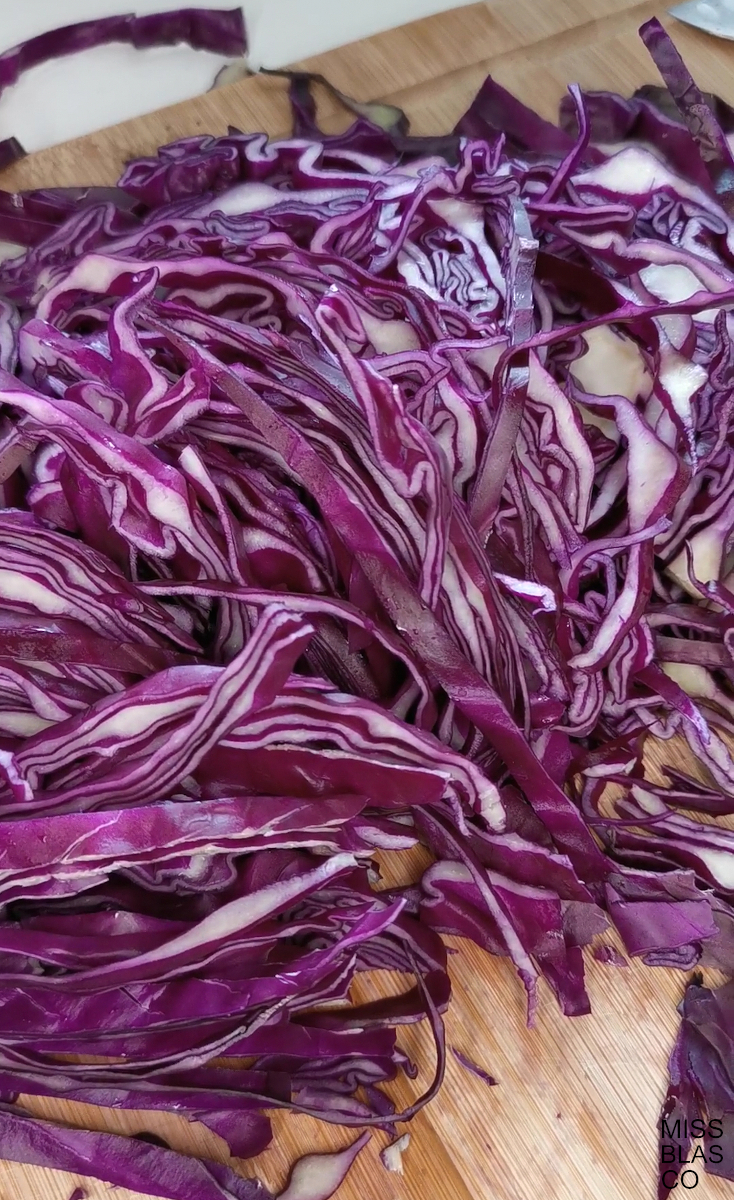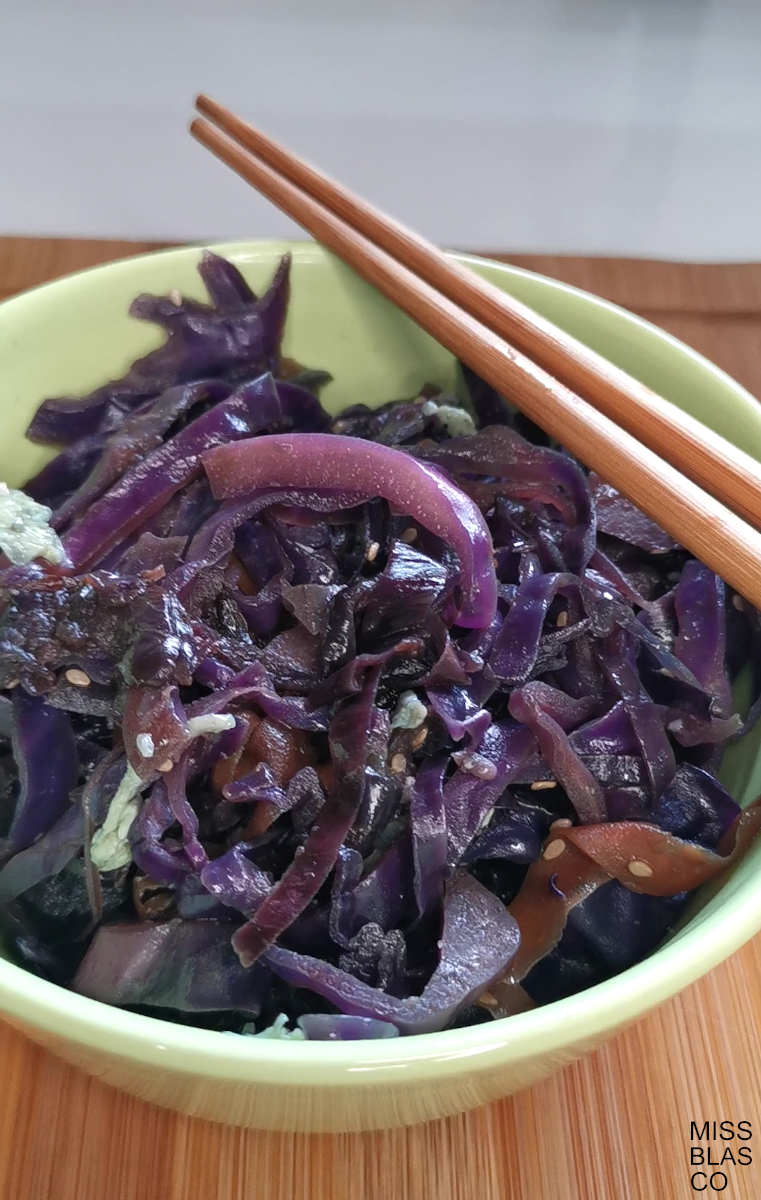
SAUTEED RED CABBAGE
I want you to see how I prepare this oriental-style red cabbage stir-fry.
One of my favorite vegetables is undoubtedly red cabbage. To be honest, I’m in love with the cabbage family. Its versatility means that I can’t stop thinking about them during the cold months to prepare a multitude of recipes.
One of those recipes is this one, oriental red cabbage stir-fry.
With very few ingredients, you get a dish with a powerful flavor and incredible texture, rich in polyphenols, with anti-inflammatory and antioxidant properties, and which provides prebiotic fiber and vitamin C.

Why eating purple foods is so beneficial
As I suppose you already know, purple foods contain polyphenols, substances with anti-inflammatory and antioxidant power.
Polyphenols act as if they were prebiotic fiber, the reason is that when ingested, 90-95% of the polyphenols are not absorbed, that is why they reach the colon and are food for our bacteria.
These are long compounds, too large to be absorbed when consumed, by bacteria of the colon feed on them, break them into smaller pieces, transform them into smaller compounds that can be absorbed with clear anti-inflammatory and anti-cancer effects.
You can distinguish the foods that contain them by their color, highlighting all the purple ones, such as red cabbage, blueberries, red berries, red onion, and also tea or red wine. (Be careful with the wine thing, I’m not saying you have to drink wine every day or that it’s the best source of polyphenols, remember that it also contains alcohol!!!).
The color of some foods indicates the presence of polyphenols
What are polyphenols:
Polyphenols are naturally occurring compounds found in a wide variety of plant-based foods, including fruits, vegetables, grains, legumes, tea, wine, and chocolate. They are known for their antioxidant and anti-inflammatory properties, making them important nutrients for health.
Polyphenols are classified into different categories based on their chemical structure, but they all share the characteristic of having multiple phenolic rings in their structure. These phenolic rings allow them to act as antioxidants, as they can neutralize free radicals and reduce oxidative stress in the body.
Some examples of polyphenols include:
- Flavonoids: Found in fruits, vegetables, tea, red wine, and dark chocolate.
- Hydroxycinnamic acid: Found in coffee, tea, cereals, and fruits.
- Stilbenes: Found in grapes, nuts, and berries.
- Proanthocyanidins: Found in fruits, such as apples and grapes, and some nuts, such as walnuts.
Polyphenols have been shown to have many health benefits, such as reducing the risk of chronic diseases like heart disease, diabetes, and cancer. They may also improve the health of your skin, brain, and immune system. Therefore, it is important to include foods rich in polyphenols in our daily diet to maintain good long-term health.
Polyphenols promote the synthesis of SCFAs (Butyrate, Acetate, Pronate…)
Benefits of polyphenols:
- They increase the microbiota ecosystem.
- They promote the synthesis of short-chain fatty acids. (SCFAs)
- When bioavailable, they have anti-inflammatory and anti-cancer properties.
- They combat oxidative stress.
- They reduce blood glucose levels.
- They improve cognitive functions and brain health.
- They reduce the risk of cardiovascular disease (CVD).
Foods rich in polyphenols:
- Purple: Red cabbage, purple beans, red onion, blueberries, blackberries, cherries.
- Green tea and especially Matcha tea.
- Green leaves
- Cabbage: Such as cabbage, Chinese cabbage and kale.
- Nuts and seeds.
- Black rice, red rice and quinoa.
- Capers
- Cacao
- Herbs: Thyme, rosemary.
- Sweet potato purple.

How to ensure sufficient polyphenol intake? By varying your diet, a wide variety of foods is essential in our eating routine; we can’t stick with “the same old thing.”
Certainly, going to the supermarket and automatically buying what you need to get through the week is the easiest thing to do, but you have to be aware that that is not enough.
The week has to be planned, and in that planning there is one element that must always be included: variety.
Eat a varied diet is essential to maintain good health.
One way to include variety in your diet is to try to consume seasonal vegetables, that way, we will be able to change the foods we consume with some regularity.
Eating a varied diet is very important because it provides us with a wide range of essential nutrients that our bodies need to function properly and maintain good health.
Each food contains a unique combination of vitamins, minerals, proteins, fats and carbohydrates, as well as other beneficial compounds, such as the polyphenols that I mentioned above.
In addition, variety in our diet helps us avoid nutritional deficiencies. Each nutrient has a specific function in the body, and a deficiency in any nutrient can lead to health problems. If our diet is limited and doesn’t include a variety of foods, we may not be getting enough of the vitamins, minerals, and other essential nutrients our bodies need to function properly. On the other hand, a varied diet can also help us maintain a healthy weight and prevent chronic diseases. Eating a variety of foods can reduce the risk of diet-related diseases, such as obesity, type 2 diabetes, heart disease, and certain types of cancer. Additionally, a varied diet can help us enjoy food more and avoid boredom from eating the same foods over and over again. Variety in our diet can improve the flavor of our meals, make them more visually appealing, and allow us to experiment with different flavors and textures. In short, eating a varied diet is important to get a wide variety of essential nutrients, avoid nutritional deficiencies, maintain a healthy weight, prevent chronic diseases, and enjoy food.
This sauteed red cabbage is an example of how to easily include polyphenol-rich foods in your diet.
Watch the video below:
I’ll leave the full recipe below. I hope you like it! ;). src=”https://www.missblasco.com/wp-content/uploads/2023/02/ColLombardaCortada_Portada_OK-150×150.jpg”/>
This oriental-style sautéed red cabbage is an easy way to include polyphenols in your diet, try it.
- 500 g red cabbage (1/2 unit)
- 100 g red onion (2 units)
- 1 clove of garlic
- 100 g carrot cut into strips (2 units)
- 1 tbsp extra virgin olive oil
- 2 tbsp soy sauce (reduced in salt)
- 4 eggs
- 1 pinch black pepper
- 1 pinch sea salt
- 1 pinch toasted sesame seeds
-
Cut the cabbage red cabbage and red onion in julienne or into thin strips
-
Peel a clove of garlic and press it.
-
In a pot, add EVOO and sauté the pressed garlic, being careful not to burn it.
-
Add the red onion and sauté with the garlic. Add salt, but only a small amount; remember that you are going to add soy sauce.
-
Now add the red cabbage. Stir it a few times and let it cook with the onion and garlic. Add pepper, cover the pot, and cook for about 15 minutes.
-
Add two tablespoons of soy sauce and mix well.
-
Meanwhile, peel the carrots and cut them into thin strips with a peeler. If you don’t have one, you can cut them into sticks.
-
Add the carrot to the stir-fry and mix. Let it cook for 5 more minutes.
-
Beat 4 eggs in a bowl and set them in a pan. They should notvery dry.
-
Add the scrambled eggs to the stir-fry and mix well. (Spoiler: The eggs will be dyed with the pigments from the cabbage and red onion.)
-
Add sesame seeds and serve in a pretty bowl. Enjoy!
Note that the egg and carrot will be dyed with the pigments from the red cabbage and red onion. If you don’t want this to happen, use cabbage, but you’ll lose the antioxidant power of those pigments.